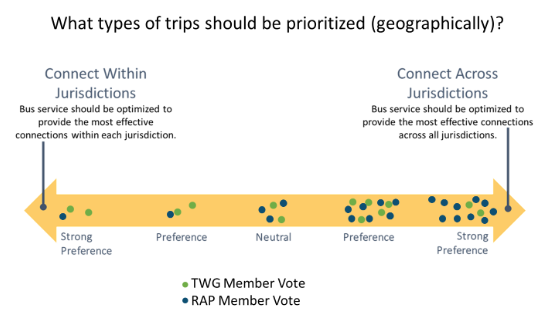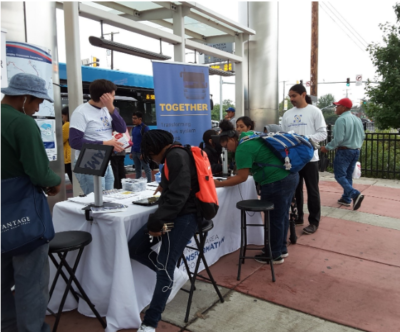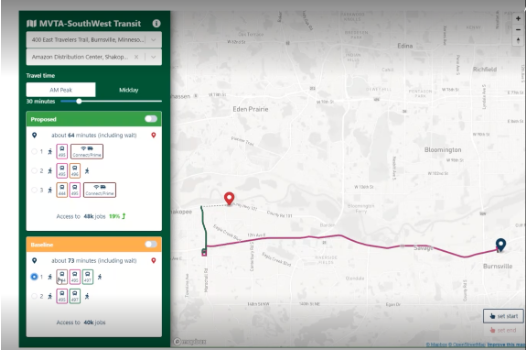I became a planner because I wanted to have a positive impact on my community. As a transportation planner, my work focuses on providing access to affordable and plentiful transportation options that meet people’s daily travel needs. But planners cannot know the community’s needs unless we ask, and that’s where outreach comes in.
The work of a transportation planner impacts the daily lives of thousands or sometimes even millions of people. We make recommendations for how to improve existing services, add new services, explore new or innovative types of services, and more. Planners at Foursquare Integrated Transportation Planning, Inc. (Foursquare ITP) have a lot of great data and tools at our disposal, but that is only part of the information we need to create successful plans. Because of the significant and personal impacts our planning efforts can have on people’s lives, it is essential to engage the community, soliciting their input and ideas, so that the recommendations we suggest truly reflect the needs and wants of the broader community. Additionally, our clients provide direction on what’s most important to them and their community, which is another crucial element of the process.
Strong Outreach Means Stronger Communities
I have been fortunate to work on several Foursquare ITP projects that include outreach components, which, when conducted effectively, lead to positive transportation outcomes. In our Regional Transit Transformation Project for Hampton Roads Transit (HRT), we developed a new vision and strategy for improving transit in HRT’s service area, comprised of six member cities. Through outreach, we learned that people prioritized having consistency in service span across all cities. As a result, Foursquare ITP developed new route classifications and new service standards that standardize span of service by route classification.

I also worked on the Washington Area Bus Transformation Project, which explored improving all aspects of bus service across nine local bus providers. Since the scale of this project was so large, it was important to get the word out to stakeholders and the public about opportunities to provide their input. This project is a good example of how Foursquare ITP married the technical aspects of planning with elements of outreach, illustrating that outreach and planning are often cyclical—our planning work can inform our outreach work while our outreach work can inform our planning work. We conducted multiple surveys throughout the project and learned that some of the highest priorities for riders were to provide more frequent, faster, and more affordable service. Survey respondents who said they sometimes take the bus instead of Metrorail reported the top reason for this decision was that the bus is more affordable.
As a result of this input, one of the recommendations in the project’s Action Plan was to “provide full transfer discount between local bus and Metrorail.” Since the completion of the project, transfers are now fully discounted between Metrobus and Metrorail, providing more affordable access to more transit options.
A more recent project I was involved with was the MVTA-SWT Systemwide Study. Foursquare ITP developed a multifaceted public outreach campaign to share information about route recommendations. We knew it was important for diverse groups to be informed about the project and have opportunities to weigh in, and we also know that people digest information in different ways. We conducted focus groups, released static and interactive maps, shared an animated video describing the proposed route changes, and launched surveys. We also created an interactive route map for stakeholder and public use that allowed users to click on a route and see its span and headways for themselves.
Foursquare ITP planners engage in outreach because our plans need to be responsive to and reflective of the whole community, which means we must get the whole picture.

Planning Effective Outreach
Outreach can have its challenges, such as when we are starting to work with a community that we have not worked in before. To overcome this challenge, we work with our clients to utilize their existing contacts with community-based organizations as well as rider advisory committees to solicit feedback and help spread the word about the project and opportunities to participate. Additionally, Foursquare ITP often partners with a firm local to that community or one that already has existing ties to it. Additionally, partnering with local organizations and firms builds trust among the public and stakeholders and may make them more inclined to participate.
Additionally, we recommend outreach approaches that meet as many different people as possible in ways that are convenient for them. For instance, instead of putting the burden on the public coming to us at a public meeting or hearing, we go to them. We may plan pop-up events at transit stations, grocery stores, community events, and other places that are convenient for people. We often have surveys or giveaways on hand to help draw people in. We also develop targeted ads, social media posts, and pop-ups in apps to meet people where they already are – virtually.
Everyone’s time is valuable, so Foursquare ITP planners try to get our main messages across through effective graphics and concise messaging. We are serving the community best when we provide lots of options to make it as easy as possible for as many people as possible to participate.
Considerations of diversity, equity, and inclusion should always be part of planning outreach efforts. Most transit riders are racial minorities¹ whereas the planning profession is predominantly white.² There can be a mismatch in the planning and implementation of outreach if the planning team’s lived experiences differ from those of the community; planners may not fully understand the needs of the community or even dismiss them (consciously or unconsciously) because of the disconnect.
Furthermore, planning has historically disregarded the needs of Black and Brown residents and actively contributed to segregation, lower quality of life, and poor health outcomes. Redlining, displacement through urban renewal and highway building, and inequitable distribution of high-quality transit services and facilities are all examples of systemic, negative transportation-related outcomes on Black and Brown communities. In particular, highway construction caused the destruction of vibrant Black communities across many cities in the United States. Now, it is our responsibility as planners to engage meaningfully with the communities we serve to ensure people have a say in what happens in their own communities and to create plans that reverse past injustices and forward racial justice and equity.

If you want to learn more about public outreach, I recommend getting involved in your local community efforts. Seeing outreach in the wild can be a great way to learn and reflect on what you think is effective outreach. Of course, you can also visit Foursquare ITP’s outreach webpage for more information on what we do and the projects we’ve worked on!
¹ APTA, Who Rides Public Transportation? https://www.apta.com/wp-content/uploads/Resources/resources/reportsandpublications/Documents/APTA-Who-Rides-Public-Transportation-2017.pdf (Accessed August 15, 2022).
² Data USA, Urban & regional planners. https://datausa.io/profile/soc/urban-regional-planners#ethnicity (Accessed August 15, 2022).